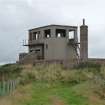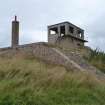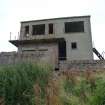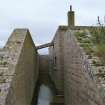Ordnance Survey licence number AC0000807262. All rights reserved. © Copyright and database right 2024.
Useful Links
- Canmore:
- TWATT AIRFIELD, CONTROL TOWER
- Historic Scotland:
- HS Reference No 51783
General Details and Location
Category
AT RISK
Name of Building
Control Tower: Twatt Aerodrome (Former)
Other Name(s)
HMS Tern
Address
Twatt
Locality
Postcode
Planning Authority
Divisional Area
Reference No
4127
Listing Category
B
OS Grid Ref
HY 26223 22942
Location Type
Rural
HS Reference No
51783
Description
Combined Royal Naval Air Service (RNAS) control tower and operations block, set in open landscape now comprising principal building of Twatt Airfield (former HMS Tern). Rendered brick. 3-storey, rectangular-plan control room and watch office adjoining single-storey operations block to form T-plan.
Part of a B Group at Twatt Airfield including: Combined Control Tower and Operations Block; 5 Air-Raid Shelters; 2 Pillboxes (see separate listings). The Royal Naval Air Service combined control tower and operations building at Twatt Airfield is an important survival of a Second World War airfield building in Orkney.
The building is an early example of this integrated design, similar to early watch offices with attached operations rooms found on RAF satellite bomber airfields in the English midlands. The blast walls and earthwork embankments surrounding the operations block to roof level indicate the perceived level of threat and the importance of maintaining airfield operations in Orkney. The internal plan also differs from standardised RNAS control tower design with a suite of rooms surrounding a central operation room at the core providing additional protection from potential bomb and gas attack. There is an internal hatch rising through the floors to the watch room. Most of the outer rooms have a window for light and ventilation. The structure occupies a prominent position on open ground within the surrounding low-lying landscape.
The strategic contribution of Orkney during World War II was nationally significant. Air defences in Orkney were a significant contributor to national security with strikes from airfields in Orkney helping to counter U-boat, surface vessel and air threats over the North Sea and at Scapa Flow. The airfield at Twatt was begun in 1940 and commissioned as HMS Tern in 1941 as a satellite of Hatston airfield for the Royal Marine engineers and remained in service until 1949. The hub of the Royal Navy's sea base operations were located at Lyness at the entrance to Scapa Flow including the Wee Fea Naval Communications and Operational Centre (see separate listings). Royal Naval Air Stations were separate from the Air Ministry and therefore developed their own distinct airfield architecture and layout. Most satellite airfields had smaller watch offices although throughout the war many were adapted as needs changed. The RNAS airfield layout tended to have 4 intersecting runways rather than the 'A' plan layout favoured by the Air Ministry (RAF). The interest of the control tower is increased by the survival of various associated WWII structures.
Of the four main military airfields in Orkney, Twatt has the greatest level of surviving WWII infrastructure with little remaining at Hatston, Skeabrae and Grimstter (Kirkwall). The surviving elements include 5 concrete air-raid shelters and 2 octagonal concrete pill boxes (see separate listings). None of the aircraft hangers remain. Other remains include the brick shells of the vehicle and parachute stores, sick bay/decontamination unit and generator house and the projection room section of the former cinema. The airfield covered 440 acres of land in 1941, extended to a total of 564 acres in 1943. There are three abandoned 19th century farmsteads within the perimeter. (Historic Scotland)
Part of a B Group at Twatt Airfield including: Combined Control Tower and Operations Block; 5 Air-Raid Shelters; 2 Pillboxes (see separate listings). The Royal Naval Air Service combined control tower and operations building at Twatt Airfield is an important survival of a Second World War airfield building in Orkney.
The building is an early example of this integrated design, similar to early watch offices with attached operations rooms found on RAF satellite bomber airfields in the English midlands. The blast walls and earthwork embankments surrounding the operations block to roof level indicate the perceived level of threat and the importance of maintaining airfield operations in Orkney. The internal plan also differs from standardised RNAS control tower design with a suite of rooms surrounding a central operation room at the core providing additional protection from potential bomb and gas attack. There is an internal hatch rising through the floors to the watch room. Most of the outer rooms have a window for light and ventilation. The structure occupies a prominent position on open ground within the surrounding low-lying landscape.
The strategic contribution of Orkney during World War II was nationally significant. Air defences in Orkney were a significant contributor to national security with strikes from airfields in Orkney helping to counter U-boat, surface vessel and air threats over the North Sea and at Scapa Flow. The airfield at Twatt was begun in 1940 and commissioned as HMS Tern in 1941 as a satellite of Hatston airfield for the Royal Marine engineers and remained in service until 1949. The hub of the Royal Navy's sea base operations were located at Lyness at the entrance to Scapa Flow including the Wee Fea Naval Communications and Operational Centre (see separate listings). Royal Naval Air Stations were separate from the Air Ministry and therefore developed their own distinct airfield architecture and layout. Most satellite airfields had smaller watch offices although throughout the war many were adapted as needs changed. The RNAS airfield layout tended to have 4 intersecting runways rather than the 'A' plan layout favoured by the Air Ministry (RAF). The interest of the control tower is increased by the survival of various associated WWII structures.
Of the four main military airfields in Orkney, Twatt has the greatest level of surviving WWII infrastructure with little remaining at Hatston, Skeabrae and Grimstter (Kirkwall). The surviving elements include 5 concrete air-raid shelters and 2 octagonal concrete pill boxes (see separate listings). None of the aircraft hangers remain. Other remains include the brick shells of the vehicle and parachute stores, sick bay/decontamination unit and generator house and the projection room section of the former cinema. The airfield covered 440 acres of land in 1941, extended to a total of 564 acres in 1943. There are three abandoned 19th century farmsteads within the perimeter. (Historic Scotland)
Building Dates
1940-41
Architects
Unknown
Category of Risk and Development History
Condition
Very Poor
Category of Risk
High
Exemptions to State of Risk
Field Visits
12/08/2009, 10/9/2013
Development History
August 2009: External inspection reveals that the building is vacant and in a derelict state.
10 September 2013: External inspection finds the building remains in much the same condition as seen previously. Orkney Islands LEADER has part funded a feasibility study on behalf of Birsay Heritage Group to explore the viability of restoring the building to exhibit building plans and artefacts for the four airfields in Orkney during WWII and air activity from WWI. Smaller artefacts collected from crashed aircraft would be held in the control tower and larger pieces in the related generator house. The building was Category B-listed in 2011 by Historic Scotland.
5 March 2024: Desk-based assessment suggest building remains At-Risk.
Guides to Development
Conservation Area
Planning Authority Contact
PAC Telephone Number
01856 873535
Availability
Current Availability
Not Available
Appointed Agents
Price
Occupancy
Vacant
Occupancy Type
N/A
Present/Former Uses
Name of Owners
Orkney Islands Council
Type of Ownership
Local Authority
Information Services
Additional Contacts/Information Source
Birsay Heritage Trust
Bibliography
Burgher, L. Orkney 1991, p.43.
Online Resources
Classification
Military Installations
Original Entry Date
25-AUG-09
Date of Last Edit
23/07/2018









